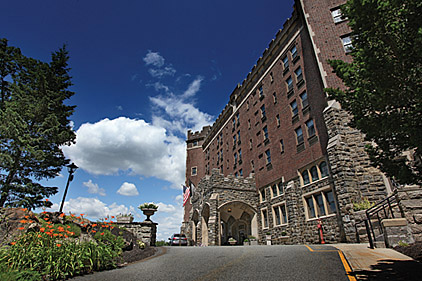Originally established to accommodate personnel and guests of the U.S. Military Academy, managing general partner Rick Minicozzi (USMA, Class of ’86) and his group were determined to reestablish its proper place as a world-class hotel and conference center.

|
|
Wireless sensors and controls saved this hotel money in energy costs. |
Paying tribute to the hotel’s historical beauty was critical, but Minicozzi also understood the importance of 21st-century amenities and sustainable operation. One major aspect of the renovation focused on installing efficient upgrades that reduce energy costs without compromising historic hotel features or the overall guest experience. These upgrades include lighting control throughout the property and guest room HVAC controls that are tied directly into the front desk.
GUEST ROOM LIGHTING SAVES ENERGY AUTOMATICALLY
Guest rooms are notorious energy hogs, and lighting control is making the biggest difference in these spaces. Before the room renovations, the lights, televisions, and air conditioners were typically left on all day whether the guest was in the room or not. Not only does this compromise the development’s group commitment to environmental responsibilities, but it plays havoc with energy bills.
Now, both the lighting and the TVs in each room automatically respond to occupancy sensors that turn them off when these spaces are vacant. For additional energy savings, the HVAC system is linked by Ethernet to the front desk, and when guests check out at the end of their visit, air conditioning levels are automatically raised to ensure that energy is not spent heating or cooling an unoccupied room. When the next guest checks in, front desk personnel make sure the temperature controls are reset, and the guests adjust according to their own preferences.
“Wireless technology allowed us to install lighting controls in each guest room without rewiring,” explains Minicozzi, “These historic rooms were not built to accommodate overhead lights, but we didn’t want to incur the expense of rewiring to install occupancy sensors in each room or to detract from the room décor. It’s also critical that our guests are not inconvenienced or uncomfortable. We’re very committed to sustainable practices, but our first commitment is to the comfort of our patrons.”
Wireless solutions made installation easy and operation automatic. When guests leave their rooms, lights turn off. Each television is plugged into an appliance module that also responds to the sensor, so when the room is vacant, the TV turns off as well. Wireless bedside controls allow guests to adjust lighting right from the comfort of their bed, and again, no rewiring was necessary.
EFFICIENT CONTROL SOLUTIONS THROUGHOUT
The hotel is also home to the Thayer Leader Development Group, which provides world-class leadership and ethics training to a wide variety of corporate entities. Known for its experiential, multi-pronged approach to executive leadership, and its ability to attract high-profile keynote speakers from the highest echelons of business and politics, the development group is confident that its unique setting and beautiful facilities are also key contributors to their success.
Automatic shading systems, daylight and occupancy sensors, preset lighting control, and digital fluorescent ballasts help make the most of the facility’s incredible location. Banks of floor-to-ceiling windows invite daylight into the space all day. The partners chose the shading and light control systems to preserve the view while eliminating unpleasant glare and heat gain. Blackout shades are also incorporated to ensure maximum visibility during A/V presentations. Daylight sensors allow electric light to be dimmed when daylight is sufficient, and occupancy sensors ensure that the lighting is off when a space is vacant.
Preset control at speaker podiums and at other key location in the conference rooms allow speakers to have total control of the lights and shades without disrupting their presentations. Each space has been designed with both energy-savings and comfort as top priorities.
These same strategies are also widely used in the bar areas and the fitness center, which is open 24/7 for guest convenience.
RESULTS
The owners already see a significant reduction in energy use as a result of the automatic light controls, and the seamless integration of the new controls hasn’t been noticed by guests at all.
Lutron shade controls in the conference facilities generate energy savings, while ensuring that guests are never isolated from one of the hotels’ most impressive assets: its prime location on the grounds of West Point, and on the banks of the Hudson River.
According to Minicozzi, “The setting is a major advantage for our conference center and a wonderful attraction for our guests. The entire hotel renovation was planned and executed to pay tribute to the hotel’s history and to sustain its place as an iconic part of this venerable institution for the future.” HPB



